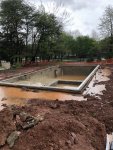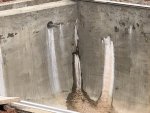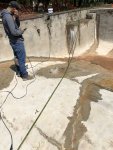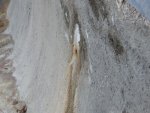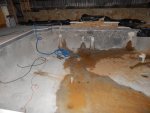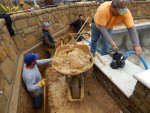Thank you to all of the contributors to this forum.
We are building an in ground pool and gunite was shot approximately 5 weeks ago. I am paying all subs directly and have an experienced project manager who builds dozens of pools managing the project.
We excavated, hit rock, and got the bigger hammer in here to break up rock. There was gravel put down, followed by steel and plumbing. Gunite was shot and then electric was installed followed by the tracks for the auto cover.
I have noticed water seeping in from the sides and one corner especially and called the gunite company out. I paid extra for 4,000psi concrete. There were a couple of small cracks on the pool floor as well which they believed at first to be stress cracks.
The gunite company came out yesterday and jackhammered into approximately 6 areas they identified and their resolution is to fill these areas with I believe it’s called leak stop. Their warranty for the gunite is for one year.
When jackhammering into one of the cracks a lot of water starting spewing out. The crack was near the bend of the pool as it goes deeper. They left a well point at the lowest part of the pool when they originally gunite and the spa also had a lot of water in it from the hydrostatic valve.
It seems as though there was a lot of ground water that was sort of stuck in the area of the middle of the pool. It has now all flowed out and I’ve pumped it out of the pool.
Questions I have include: What do I do about the groundwater now and in the future? I plan on installing a French drain towards the back of the pool where there is a slight hill upwards. I also plan on installing surface drains around the other areas of the pool.
But do I need to get an engineer involved to test the concrete? Any other ideas on if I should be asking the gunite company to do anymore or any other ideas on groundwater management now that the pool has been shot. I understand some folks have put in a pump at the bottom to help with groundwater issues but we did not. Should we do this now?
I appreciate any and all advice! I am putting up as many pictures as possible for your all’s review. Thanks again!
We are building an in ground pool and gunite was shot approximately 5 weeks ago. I am paying all subs directly and have an experienced project manager who builds dozens of pools managing the project.
We excavated, hit rock, and got the bigger hammer in here to break up rock. There was gravel put down, followed by steel and plumbing. Gunite was shot and then electric was installed followed by the tracks for the auto cover.
I have noticed water seeping in from the sides and one corner especially and called the gunite company out. I paid extra for 4,000psi concrete. There were a couple of small cracks on the pool floor as well which they believed at first to be stress cracks.
The gunite company came out yesterday and jackhammered into approximately 6 areas they identified and their resolution is to fill these areas with I believe it’s called leak stop. Their warranty for the gunite is for one year.
When jackhammering into one of the cracks a lot of water starting spewing out. The crack was near the bend of the pool as it goes deeper. They left a well point at the lowest part of the pool when they originally gunite and the spa also had a lot of water in it from the hydrostatic valve.
It seems as though there was a lot of ground water that was sort of stuck in the area of the middle of the pool. It has now all flowed out and I’ve pumped it out of the pool.
Questions I have include: What do I do about the groundwater now and in the future? I plan on installing a French drain towards the back of the pool where there is a slight hill upwards. I also plan on installing surface drains around the other areas of the pool.
But do I need to get an engineer involved to test the concrete? Any other ideas on if I should be asking the gunite company to do anymore or any other ideas on groundwater management now that the pool has been shot. I understand some folks have put in a pump at the bottom to help with groundwater issues but we did not. Should we do this now?
I appreciate any and all advice! I am putting up as many pictures as possible for your all’s review. Thanks again!
Attachments
Last edited:


